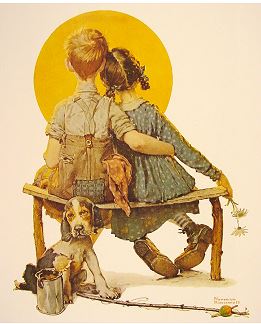Norman Rockwell (1894-1978) was an American asrtist most famous for his cover illustrations for The Saturday Evening Post. He contributed over 300 covers during a period of more than 40 years. This picture served as a propaganda poster in World War 2 and was used as the magazine's cover in May 1943. Women were encouraged to fill the jobs left vacant when the men went to war and Rosie was a kind of ideal. She became a feminist icon.
 |
| Norman Rockwell, Rosie The Riveter, 1943 |
Rockwell's model was a nineteen-year-old phone operator named Mary Doyle Keefe. She was a very petite young lady and said that Rockwell phoned her after the painting was completed to apologise for making her look so big. That was not an accident of course; the idea was to show that women could be strong and easily do men's jobs. The picture has iconic status in the United States and was sold to a museum for $5 million in 2002. Rosie is seen eating a ham sandwich with a huge (light-weight fake) riveting gun on her lap. She has her foot placed, symbolically, on a copy of Hitler's Mein Kampf. The picture was sent on a touring exhibition to encourage people to buy war bonds along with a set of four pictures called Freedom of Worship, Freedom from Fear, Freedom from Want and Freedom of Speech.
 |
| The Four Freedoms |
Rockwell has often been dismissed as a proper artist largely because of the perceived "cartoonish" sentimentality of his subjects. Critics would say that he is an illustrator rather than an artist. He had no problem with that and even referred to himself as an illustrator. However, I think he is hard done by. His paintings show obvious great skill and technique with superb compositions. His work was not always sentimental. Consider the picture below.
 |
| Norman Rockwell, The Problem We All Live With, 1964 |
This a very serious picture. The little girl is being escorted into a school in the south by US Marshalls. They are headless and the girl is highlighted to make sure that she captures your attention. Rockwell made her dress white (it was dark grey in reality) so that it formed a high contrast with her dark skin. The rest of the picture is fairly 'grey' with the shocking exception of the rotten tomatoes that have been thrown and the yellow armbands. Also the whole picture forms a golden rectangle as does the ratio, top left from her chest. None of this is accidental, including the way she appears the be 'boxed-in' by the marshals.
On a lighter note, much of the imagery in the film Forrest Gump is based on Rockwell's work.
And finally a look at a very typical and much reproduced early work:
 |
| Rockwell Young Forrest Gump |
 |
| Gazing at the Moon, 1926
I am listening to Betty Wright's Clean Up Woman. A brilliant 70s soul recording with fabulous guitar playing by Willie "Little Beaver" Hale.
|

8 comments:
Hello Bazza, I have never believed much in labels and categories, especially when they are used dismissively. Illustrators bring a text or subject to life, but so does real art, and when the illustration goes beyond a literal depiction, it naturally assumes metaphoric qualities. Also, when the degree of craftsmanship exceed the workmanlike, it does enter the realm of art.
--Jim
Very nicely expressed Jim - I wish I'd said that in my post! (Esprit de l'escalier?)
Not only the USA been reluctant to get involved in WW2 until after Pearl Harbour but married women had felt even less welcome in the wartime work force. So Rosie the Riveter was a brilliant idea. That government drive created great posters of strong, healthy and committed women who were prepared to work in unfeminine jobs eg armaments.
My favourite is a working woman, flexing her arm muscle and saying We Can Do It!! Go Rosie.. go Rockwell!
Yes Hels, there are lots of other versions of Rosie - I am sure Rockwell did not create her but, when I studied Popular Culture as part of my degree, she was a big topic.
Hi bazza,
The only times I've heard Norman Rockwell's name mentioned it's always been said in a tone of slightly sneering contempt, with him being seen as a sentimental purveyor of wholesome "Americanness". However, your illuminating post shows that he did have at least some grip of American social problems and issues. The only picture of his I was really familiar with before this was "The Flirts", which is on the cover of my copy of "The Penguin Book of American Short Stories", which I bought whilst at university!
Thanks for another interesting post, bazza.
All the best,
David.
Hello David. Because they are subjective, reactions to paintings (and other art-forms) go in and out of fashion and Rockwell is now taken more seriously. And anyway he did show a more socially-aware side later in his long career. The Flirts, like lots of his work has a strong narrative element and would have been perfect for a book of American short stories.
Hi Bazza - I know little about Rockwell - so was grateful to read your post and thoughts ... when I see his work again I'll add a little more to your knowledge and at some stage I'll read up some more ... his cultural look at American life is thought provoking that's for sure - cheers Hilary
Hi Hilary. Rockwell is a topic all on his own. There is plenty to say about his skill and on his social meaning although he would have denied that he had one!
Post a Comment